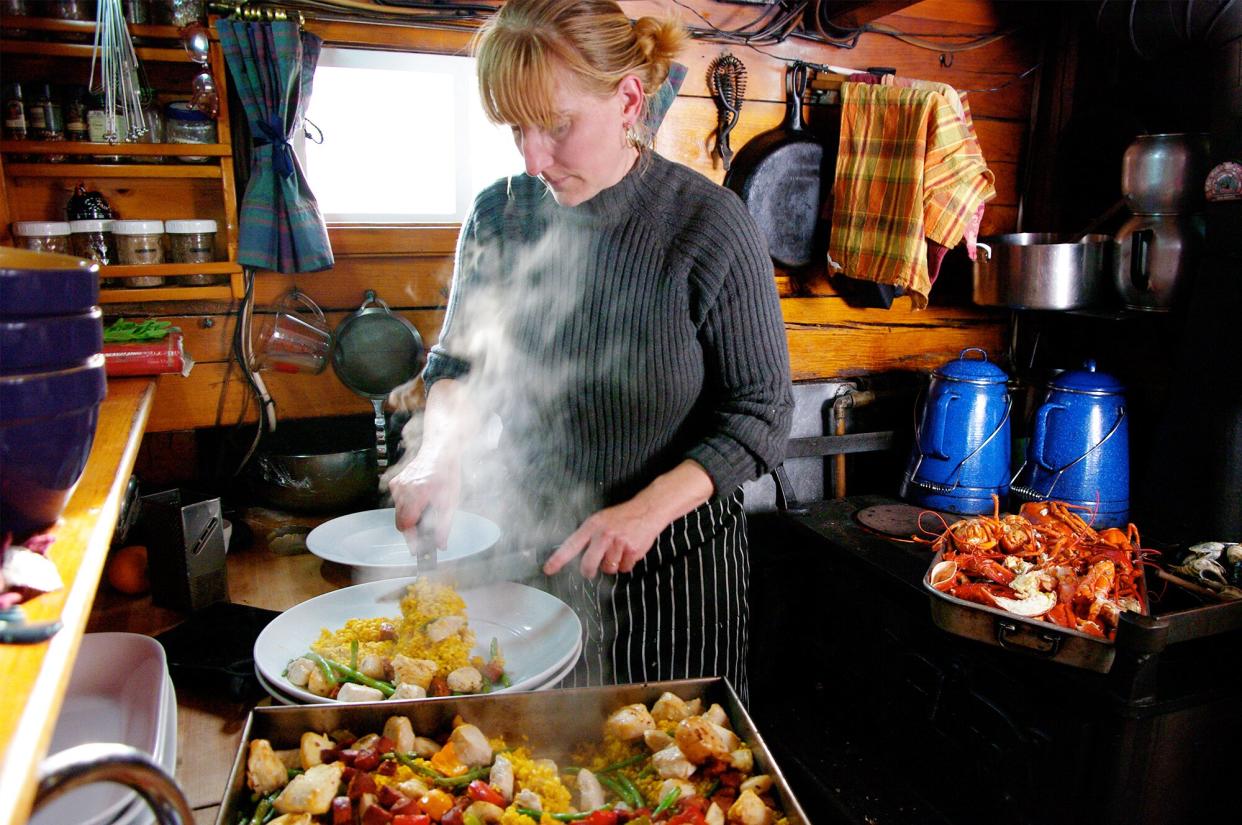Tiny Kitchen Cooking Tips from Chef Annie Mahle, Who Works in a Galley Kitchen on a Boat

Courtesy of Annie Mahle / Storey Books
Good things may come in small packages, but when it comes to cooking, small kitchens present quite a few challenges—is there enough counter space to prep food and still have our beloved Instant Pot? And where to store all our pots and pans? Tiny kitchens require ingenious organization skills and some self-editing—maybe we don't really need that Instant Pot after all—and the ability to adapt the way we think about creating and cooking meals. But that doesn't mean you can't bake your grandma's favorite banana bread or that paella you've been perfecting.
Related: How Award-Winning Nutritionist Ellie Kreiger Keeps Weeknight Meals Healthy
"Essentially, every space you cook in has things you can take advantage of and then things that are just not going to happen in them," says Annie Mahle. The chef and author of The Tiny Kitchen Cookbook: Strategies and Recipes for Creating Amazing Meals in Small Spaces has always found herself cooking in small spaces, including creating three meals a day for guests when she was chef on a Maine Windjammer. "It just sort of happened," says Mahle about how she became an expert at cooking in small spaces. "Many of us have pinned for those really big, large, lovely sprawling kitchens," but like Mahle, we end up cooking in smaller ones.
If your current kitchen is tiny and that's something that annoys you on a daily basis, or you're going to be spending a few weeks or months in an RV or on a boat, know that no matter how small your cooking space is, it is possible to create incredibly delicious meals in it. Here are Mahle's 3 top tips for cooking in small kitchens.
Tips for Cooking in Small Kitchens
Organize
The more organized you are, the easier it is to clean in a small space. "Everything needs to have its place; nothing can be out on the counter if you only have 2 square feet of space," says Mahle. She recommends taking advantage of any usable space by hanging things up, finding places to tuck pans on the side of countertops, and stacking.
Self Edit
It's impossible to have every imaginable kitchen tool in a small space. The good news is that you probably really didn't need all those gizmos anyway. When you're thinking about what tools you need, Mahle suggests asking yourself if the tool is vital to the work you're doing in the kitchen, and if it is, is there another tool that will do the same thing. For instance, you may be able to lose the toaster and make toast in your cast-iron skillet.
Clean
You have to get in the habit of cleaning as you go in a tiny kitchen." Restaurant kitchens are all small, so you work on something and then clean it up and the start another [thing] and then clean up," says Mahle. "It's a habit that translates super well to small kitchens as there's no way to do it unless you're organizing, stacking, and cleaning as you go."
What to Cook in a Small Kitchen
A tiny kitchen will likely change how you cook. "The type of recipes I choose for a tiny kitchen only use one or two pans," says Mahle, who adds that she favors recipes that require simple prep and not a lot of cleanup. (Don't we all?)
On the boat with limited propane, Mahle gravitated towards thinner cuts of meat, such as pork tenderloin instead of pork loin, fish, and other proteins that don't take as long to cook. "If meat is the flavoring but not the main course, you don't need as much meat," says Mahle. "Then you have nuts with it or Greek yogurt, or beans and vegetables."
She's also a big proponent of using leftovers in creative ways, such as adding eggs to whatever was leftover and making an omelet or frittata, or making a salad with an excess protein. "So if we had meat or fish the night before, then I'd create a salad that is the main dish and build it in a big bowl," says Mahle.
Her final tip applies not only to cooking in a small kitchen, it's useful for every home cook. When creating any dish, start simple, and then as you get better at creating a meal, whether it's from leftovers or scratch, you can add more things to it.

